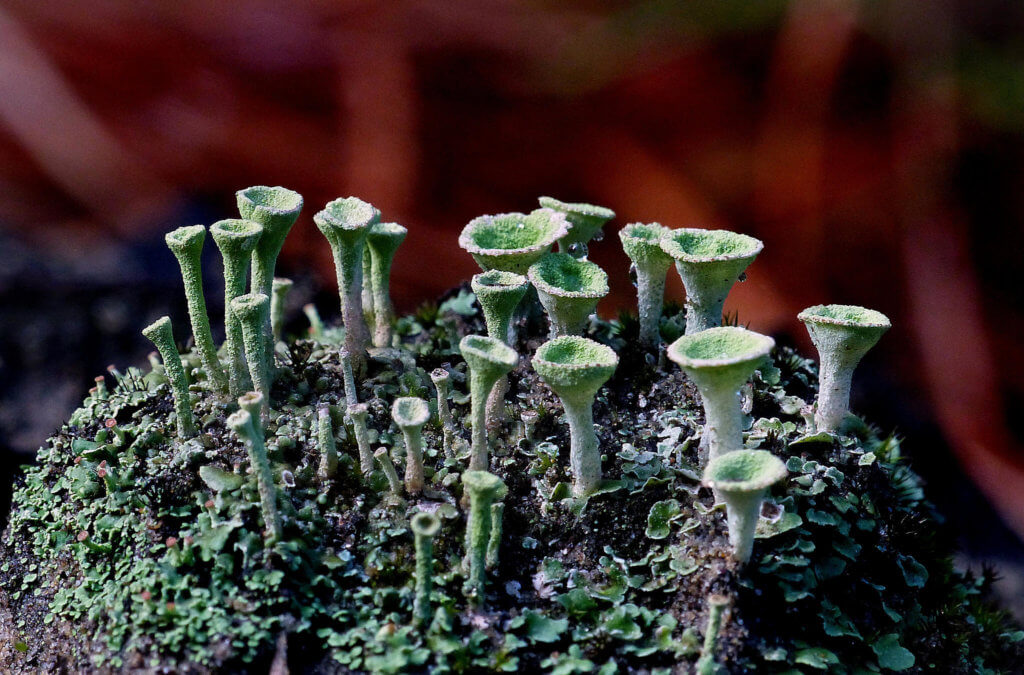Pixie Cup Lichen
by Erin Ebersberger
Broadcast 7.1 & 7.6.2018

Photo by Bernard Spragg, public domain.
Listen:
Lying on my stomach on the fringes of the forest, my view is perfect of a colony of tiny lichens. They are perched on top of a rock outcrop, beyond which lies a majestic view eastward across the cold, choppy waters of Flathead Lake and on to the Mission Mountains looming on the opposite shore.
The lichens resemble pale green miniature goblets, and look as though carefully set on a table of bright green moss.
While watching them I almost expect to find light-footed wood fairies flitting around, gulping single raindrops from the tiny lichen chalices. These lichens are one of those things in nature that make you want to shrink down like Alice to get a better look at their intricate wonderland.
Although “goblet-shaped” is an accurate description, these lichens seem much more animated than little chalices. Some grow huddled in groups that look like families. Each family is complete with several parents, and a group of small children gathered around as if listening to the telling of an ancient, unspoken tale.
Each little cup is coated in a powdery mint-green dust that rubs off easily onto my hand. Is this the fabled magic fairy dust, or is there another explanation? What more can we discover about this mini-landscape?
I was looking at the mealy pixie cup lichen, also known as Cladonia chlorophaea. In spite of their single scientific name, lichens are actually two organisms, algae and fungi, partnered in a mutually beneficial or symbiotic relationship. The structure of a lichen is the fungus, which creates a mini-ecosystem inhabited by a colony or algae or cyanobacteria, sometimes both. The algae provide food by performing photosynthesis, while the fungus provides stability and absorbs nutrients from the environment. This partnership allows both organisms to thrive in areas where they could not survive alone.
The family formations in the colony and the dust-covered appearance of the goblets are both clues to the lichen’s method of reproduction. The mealy pixie-cup lichen reproduces by one of two processes: fragmentation or the production of propagules. Fragmentation occurs when a patch of this lichen is trampled or touched. The bodies may break apart, and each fragment has the potential to become a new lichen.
The powdery, fairy dust I noticed is actually made up of soredia, the formal name for the lichen’s propagules. Each granule, or soredium, is composed of a few algal and a few fungal cells, and when spread is capable of becoming a new lichen. It is through these two methods of reproduction that the Cladonia colony derives its family-like character. Each pixie cup is continually producing its surrounding offspring.
This colony of Cladonia chlorophaea, and all of its lichen siblings, are extremely hardy organisms. Some can even endure temperatures as low as -60 degrees Celsius. They grow extremely slowly, but make up for slow growth with incredible longevity. Some are thought to be as old as 4,500 years.
Lichens are points of strength and hardiness, tempered by meekness and near anonymity. The miniature world of lichens is a fascinating and important part of nature. The mealy pixie cup lichen is just one of thousands of varieties of distinct and interesting lichens, which appear in a myriad of places. So next time you enter the forest, kneel down and take a good look at the lichens. They are a tiny forest for the pixies, a part of the magic of the woods.
Every week since 1991, Field Notes has inquired about Montana’s natural history. Field Notes are written by naturalists, students, and listeners about the puzzle-tree bark, eagle talons, woolly aphids, and giant puffballs of Western, Central and Southwestern Montana and aired weekly on Montana Public Radio.
Click here to read and listen to more Field Notes. Field Notes is available as a podcast! Subscribe on iTunes, Google Play, or wherever you listen to podcasts.
Interested in writing a Field Note? Contact Allison De Jong, Field Notes editor, at adejong [at] montananaturalist [dot] org or 406.327.0405.
Want to learn more about our programs as well as fun natural history facts and seasonal phenology? Sign up for our e-newsletter! You can also become a member and get discounts on our programs as well as free reciprocal admission to 300+ science centers in North America!












